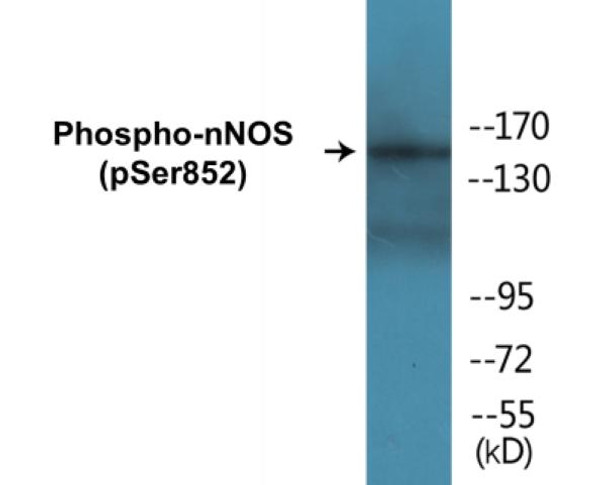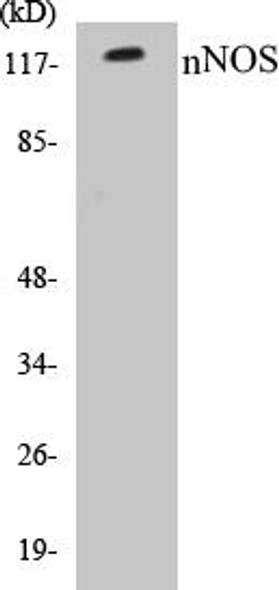Description
nNOS (Phospho-Ser852)Colorimetric Cell-Based ELISA Kit
The Human nNOS (Phospho-Ser852) Colorimetric Cell-Based ELISA Kit is specifically designed for the accurate detection of phosphorylated nNOS levels in cell lysates and tissue homogenates. This kit offers high sensitivity and specificity, allowing for reliable and reproducible results, making it ideal for studying the role of nNOS in various biological processes.nNOS, or neuronal nitric oxide synthase, is a key enzyme involved in the production of nitric oxide, a signaling molecule that plays a crucial role in various physiological processes such as neurotransmission, vasodilation, and immune response.
Phosphorylation of nNOS at Ser852 has been linked to its activity and regulation, making it a valuable marker for understanding the pathophysiology of diseases such as neurodegenerative disorders, cardiovascular diseases, and inflammation.With this advanced ELISA kit, researchers can accurately measure the levels of phosphorylated nNOS in biological samples, allowing for a better understanding of its role in health and disease. This kit is a valuable tool for studying signaling pathways, drug development, and potential therapeutic interventions targeting nNOS.
| Product Name: | nNOS (Phospho-Ser852)Colorimetric Cell-Based ELISA Kit |
| Product Code: | CBCAB01306 |
| ELISA Type: | Cell-Based |
| Target: | nNOS (Phospho-Ser852) |
| Reactivity: | Human, Mouse, Rat |
| Dynamic Range: | > 5000 Cells |
| Detection Method: | Colorimetric 450 nm |
| Format: | 2 x 96-Well Microplates |
The nNOS (Phospho-Ser852) Colorimetric Cell-Based ELISA Kit is a convenient, lysate-free, high throughput and sensitive assay kit that can detect nNOS protein phosphorylation and expression profile in cells. The kit can be used for measuring the relative amounts of phosphorylated nNOS in cultured cells as well as screening for the effects that various treatments, inhibitors (ie. siRNA or chemicals), or activators have on nNOS phosphorylation.
Qualitative determination of nNOS (Phospho-Ser852) concentration is achieved by an indirect ELISA format. In essence, nNOS (Phospho-Ser852) is captured by nNOS (Phospho-Ser852)-specific primary (1ø) antibodies while the HRP-conjugated secondary (2ø) antibodies bind the Fc region of the 1ø antibody. Through this binding, the HRP enzyme conjugated to the 2ø antibody can catalyze a colorimetric reaction upon substrate addition. Due to the qualitative nature of the Cell-Based ELISA, multiple normalization methods are needed:
| 1. | A monoclonal antibody specific for human GAPDH is included to serve as an internal positive control in normalizing the target absorbance values. |
| 2. | Following the colorimetric measurement of HRP activity via substrate addition, the Crystal Violet whole-cell staining method may be used to determine cell density. After staining, the results can be analysed by normalizing the absorbance values to cell amounts, by which the plating difference can be adjusted. |
| Database Information: | Gene ID: 4842, UniProt ID: P29475, OMIM: 163731/179010, Unigene: Hs.654410 |
| Gene Symbol: | NOS1 |
| Sub Type: | Phospho |
| UniProt Protein Function: | nNOS: nitric oxide synthase 1, neuronal form. Produces nitric oxide which is a messenger molecule with diverse functions and displays many properties of a neurotransmitter in the brain and peripheral nervous system. May be an effector enzyme for the dystrophin complex. Four alternatively spliced isoforms have been described. |
| UniProt Protein Details: | Protein type:Amino Acid Metabolism - arginine and proline; EC 1.14.13.39; Oxidoreductase Chromosomal Location of Human Ortholog: 12q24.22 Cellular Component: cytoplasm; cytoskeleton; cytosol; lipid raft; mitochondrion; nucleoplasm; perinuclear region of cytoplasm; photoreceptor inner segment; plasma membrane; protein complex; sarcolemma; sarcoplasmic reticulum; synapse Molecular Function:cadmium ion binding; FAD binding; FMN binding; heme binding; NADP binding; NADPH-hemoprotein reductase activity; nitric-oxide synthase activity; protein binding; sodium channel regulator activity Biological Process: arginine catabolic process; cell redox homeostasis; exogenous drug catabolic process; multicellular organismal response to stress; myoblast fusion; negative regulation of blood pressure; negative regulation of calcium ion transport; negative regulation of hydrolase activity; negative regulation of potassium ion transport; negative regulation of serotonin uptake; neurotransmitter biosynthetic process; nitric oxide biosynthetic process; nitric oxide mediated signal transduction; peptidyl-cysteine S-nitrosylation; positive regulation of guanylate cyclase activity; positive regulation of histone acetylation; positive regulation of transcription from RNA polymerase II promoter; positive regulation of transcription, DNA-dependent; regulation of sodium ion transport; response to heat; response to hypoxia; striated muscle contraction; vasodilation Disease: Pyloric Stenosis, Infantile Hypertrophic, 1 |
| NCBI Summary: | The protein encoded by this gene belongs to the family of nitric oxide synthases, which synthesize nitric oxide from L-arginine. Nitric oxide is a reactive free radical, which acts as a biologic mediator in several processes, including neurotransmission, and antimicrobial and antitumoral activities. In the brain and peripheral nervous system, nitric oxide displays many properties of a neurotransmitter, and has been implicated in neurotoxicity associated with stroke and neurodegenerative diseases, neural regulation of smooth muscle, including peristalsis, and penile erection. This protein is ubiquitously expressed, with high level of expression in skeletal muscle. Multiple transcript variants that differ in the 5' UTR have been described for this gene but the full-length nature of these transcripts is not known. Additionally, alternatively spliced transcript variants encoding different isoforms (some testis-specific) have been found for this gene.[provided by RefSeq, Feb 2011] |
| UniProt Code: | P29475 |
| NCBI GenInfo Identifier: | 1709333 |
| NCBI Gene ID: | 4842 |
| NCBI Accession: | P29475.2 |
| UniProt Secondary Accession: | P29475,O75713, E9PH30, |
| UniProt Related Accession: | P29475 |
| Molecular Weight: | 161kDa |
| NCBI Full Name: | Nitric oxide synthase, brain |
| NCBI Synonym Full Names: | nitric oxide synthase 1 |
| NCBI Official Symbol: | NOS1 |
| NCBI Official Synonym Symbols: | NOS; bNOS; nNOS; IHPS1; N-NOS; NC-NOS |
| NCBI Protein Information: | nitric oxide synthase, brain |
| UniProt Protein Name: | Nitric oxide synthase, brain |
| UniProt Synonym Protein Names: | Constitutive NOS; NC-NOS; NOS type I; Neuronal NOS; N-NOS; nNOS; Peptidyl-cysteine S-nitrosylase NOS1; bNOS |
| Protein Family: | Nitric oxide synthase |
| UniProt Gene Name: | NOS1 |
| Component | Quantity |
| 96-Well Cell Culture Clear-Bottom Microplate | 2 plates |
| 10X TBS | 24 mL |
| Quenching Buffer | 24 mL |
| Blocking Buffer | 50 mL |
| 15X Wash Buffer | 50 mL |
| Primary Antibody Diluent | 12 mL |
| 100x Anti-Phospho Target Antibody | 60 µL |
| 100x Anti-Target Antibody | 60 µL |
| Anti-GAPDH Antibody | 60 µL |
| HRP-Conjugated Anti-Rabbit IgG Antibody | 12 mL |
| HRP-Conjugated Anti-Mouse IgG Antibody | 12 mL |
| SDS Solution | 12 mL |
| Stop Solution | 24 mL |
| Ready-to-Use Substrate | 12 mL |
| Crystal Violet Solution | 12 mL |
| Adhesive Plate Seals | 2 seals |
The following materials and/or equipment are NOT provided in this kit but are necessary to successfully conduct the experiment:
- Microplate reader able to measure absorbance at 450 nm and/or 595 nm for Crystal Violet Cell Staining (Optional)
- Micropipettes with capability of measuring volumes ranging from 1 µL to 1 ml
- 37% formaldehyde (Sigma Cat# F-8775) or formaldehyde from other sources
- Squirt bottle, manifold dispenser, multichannel pipette reservoir or automated microplate washer
- Graph paper or computer software capable of generating or displaying logarithmic functions
- Absorbent papers or vacuum aspirator
- Test tubes or microfuge tubes capable of storing ≥1 ml
- Poly-L-Lysine (Sigma Cat# P4832 for suspension cells)
- Orbital shaker (optional)
- Deionized or sterile water
*Note: Protocols are specific to each batch/lot. For the correct instructions please follow the protocol included in your kit.
| Step | Procedure |
| 1. | Seed 200 µL of 20,000 adherent cells in culture medium in each well of a 96-well plate. The plates included in the kit are sterile and treated for cell culture. For suspension cells and loosely attached cells, coat the plates with 100 µL of 10 µg/ml Poly-L-Lysine (not included) to each well of a 96-well plate for 30 minutes at 37 °C prior to adding cells. |
| 2. | Incubate the cells for overnight at 37 °C, 5% CO2. |
| 3. | Treat the cells as desired. |
| 4. | Remove the cell culture medium and rinse with 200 µL of 1x TBS, twice. |
| 5. | Fix the cells by incubating with 100 µL of Fixing Solution for 20 minutes at room temperature. The 4% formaldehyde is used for adherent cells and 8% formaldehyde is used for suspension cells and loosely attached cells. |
| 6. | Remove the Fixing Solution and wash the plate 3 times with 200 µL 1x Wash Buffer for five minutes each time with gentle shaking on the orbital shaker. The plate can be stored at 4 °C for a week. |
| 7. | Add 100 µL of Quenching Buffer and incubate for 20 minutes at room temperature. |
| 8. | Wash the plate 3 times with 1x Wash Buffer for 5 minutes each time. |
| 9. | Add 200 µL of Blocking Buffer and incubate for 1 hour at room temperature. |
| 10. | Wash 3 times with 200 µL of 1x Wash Buffer for 5 minutes each time. |
| 11. | Add 50 µL of 1x primary antibodies Anti-nNOS (Phospho-Ser852) Antibody, Anti-nNOS Antibody and/or Anti-GAPDH Antibody) to the corresponding wells, cover with Parafilm and incubate for 16 hours (overnight) at 4 °C. If the target expression is known to be high, incubate for 2 hours at room temperature. |
| 12. | Wash 3 times with 200 µL of 1x Wash Buffer for 5 minutes each time. |
| 13. | Add 50 µL of 1x secondary antibodies (HRP-Conjugated AntiRabbit IgG Antibody or HRP-Conjugated Anti-Mouse IgG Antibody) to corresponding wells and incubate for 1.5 hours at room temperature. |
| 14. | Wash 3 times with 200 µL of 1x Wash Buffer for 5 minutes each time. |
| 15. | Add 50 µL of Ready-to-Use Substrate to each well and incubate for 30 minutes at room temperature in the dark. |
| 16. | Add 50 µL of Stop Solution to each well and read OD at 450 nm immediately using the microplate reader. |
(Additional Crystal Violet staining may be performed if desired – details of this may be found in the kit technical manual.)






